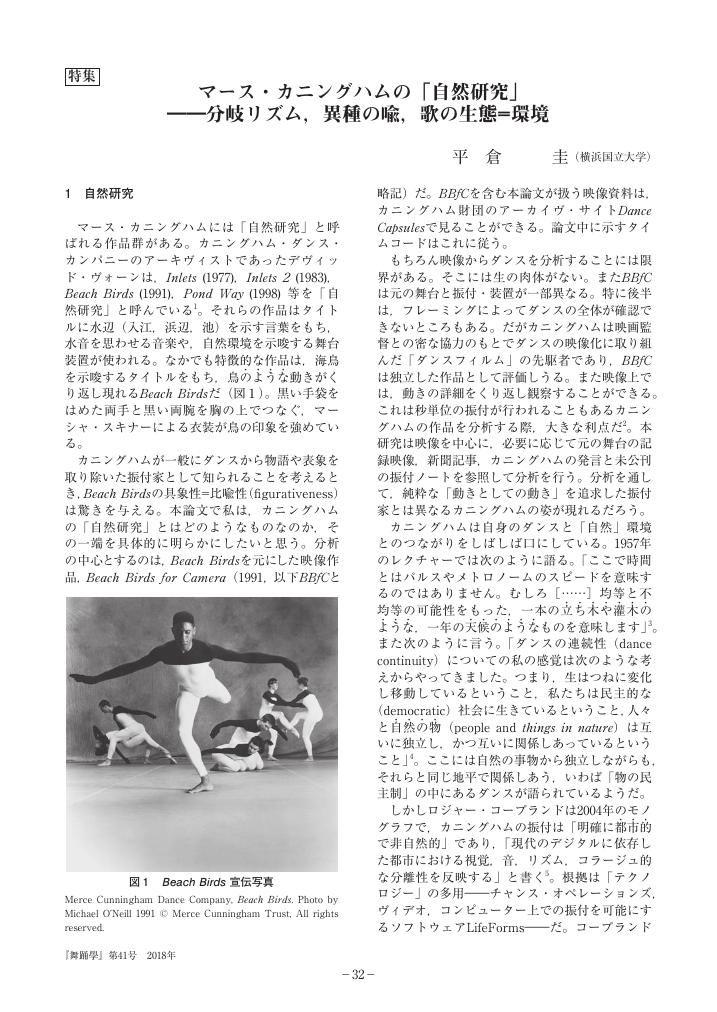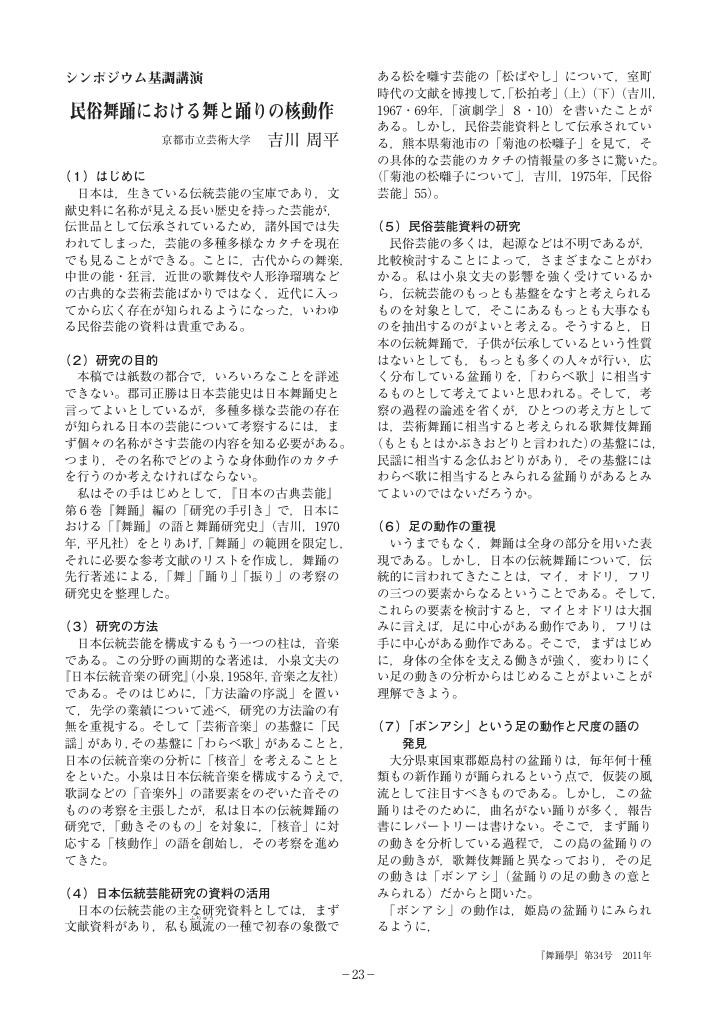6 0 0 0 OA 『ツァラトゥストラ』における「舞踊」の意味
- 著者
- 鈴木 江理子
- 出版者
- 舞踊学会
- 雑誌
- 舞踊學 (ISSN:09114017)
- 巻号頁・発行日
- vol.1991, no.13, pp.7-12, 1991 (Released:2010-04-30)
- 参考文献数
- 10
6 0 0 0 OA 音のブリコラージュ ダンス・ミュージックと部族楽器としてのTB-303
- 著者
- 岡田 桂
- 出版者
- 舞踊学会
- 雑誌
- 舞踊學 (ISSN:09114017)
- 巻号頁・発行日
- vol.2009, no.32, pp.12-23, 2009 (Released:2018-06-18)
Today, we can see the tendency that much part of popular music is oriented towards dance music. The elements of dance-oriented popular music, especially of those rhythms are majorly influenced by House/Techno music which was emerged around the early 1980’s from the underground night club scene in the United State. This article intends to examine the reason how and why House music was invented and about to strongly influence on popular music. In the process of examination, it is mentioned that a unique role of Japanese synthesizer named TB-303 which contributed towards developing the early scene of Acid House Music. The major group to invent and bring up House music was gay Afro-Americans in that time and they should be recognized as subcultural tribe in terms of urban sociology/cultural studies. In this paper, I regard the House music as the practice of bricolage by urban tribe and as TB-303 as tribal musical instrument. Also the trend of embodiment of music is discussed through the process in which popular music is about to change from the thing to listen towards something to feel.
5 0 0 0 OA 韓国券番 (1908-1942) における妓生教育
- 著者
- 許 娟姫
- 出版者
- 舞踊学会
- 雑誌
- 舞踊學 (ISSN:09114017)
- 巻号頁・発行日
- vol.2008, no.31, pp.48-59, 2008 (Released:2010-04-30)
Kwonbon is one of the systems transplanted from Japan to Korea during colony period and had been maintained from 1908 to 1942 under the governance of Japan. Kwonbon is mostly in charge of business management and art education for Geisha. Kwonbon system in Japan like this was applied to Korea in almost the same form with a policy. Kiseng, that is Female artists from the Palace and the Government, is an object. Kiseng during colony period had made a living and had kept traditional music and dance.Kwonbon had been completely disappeared around 1950's. However traditional dancers who have been lived in those periods testifies that numerous Korean traditional dancer including those who have important intangible cultural assets were educated at Kwonbon.This study focuses on how Kwonbon in Japan was transplanted and had rooted in Joseon (Korea), what was the details of education for Kiseng, and what kind of dance was educated. First of all, as a background of Kiseng education at Kwonbon, history from the introduction of Kiseng Union whose predecessor to the establishment of Kwonbon is reviewed and the role of Kwonbon as an administrative organization is summarized. From the examples of Seven Kwonbon in each area, basic Kiseng education and teacher, and details of dance education are studied.
5 0 0 0 OA 舞踊学の新しい方法を探る
- 著者
- 外山 紀久子
- 出版者
- 舞踊学会
- 雑誌
- 舞踊學 (ISSN:09114017)
- 巻号頁・発行日
- vol.1995, no.17, pp.54-56, 1995 (Released:2010-04-30)
4 0 0 0 OA 脚支持に関与する要因について
4 0 0 0 OA 素足で踊る舞踊のための身体運動の技術としての「回転」
- 著者
- 堀切 敍子
- 出版者
- 舞踊学会
- 雑誌
- 舞踊學 (ISSN:09114017)
- 巻号頁・発行日
- vol.1998, no.21, pp.50-50, 1998 (Released:2010-04-30)
3 0 0 0 OA 戦後の舞踊作品における「黒人の表象」を巡って
- 著者
- 宮川 麻理子
- 出版者
- 舞踊学会
- 雑誌
- 舞踊學 (ISSN:09114017)
- 巻号頁・発行日
- vol.2021, no.44, pp.20-31, 2021-12-25 (Released:2023-04-24)
This paper investigates how Japanese dancers have represented ‘black’ or ‘black people’ (Kokujin) in their performances and analyzes their meanings, their ambivalent feelings towards Kokujin, and the influence of American diplomacy in the Post-War period. In Hijikata Tatsumi’s dance piece Kinjiki (Forbidden Colors) in 1959, thought as the first Butoh performance, he painted his body black to represent the black male character from Jean Genet’s novel. However, it was not only Hijikata who performed ‘black’ in this period. After WWⅡ, Japanese dancers picked up the subject that concern to black people such as the social movements of Afro-American, or used music and dance techniques related to black culture, and performed some representations of blackness by various ways especially in the period of 1950s-70s. Here, we can point out the influence of dancers who came to Japan such as Katherine Dunham or Alwin Ailey, and the jazz music that spread during this era, and the US’s policy towards Japan lay behind them. This study will show that in these representations of black people, there is a sense of solidarity of Japanese dancers with Afro-Americans, problems of discrimination that existed in different phases in Japan, and also Japanese people’s own prejudice towards black people.
3 0 0 0 OA マース・カニングハムの「自然研究」 分岐リズム,異種の喩,歌の生態=環境
- 著者
- 平倉 圭
- 出版者
- 舞踊学会
- 雑誌
- 舞踊學 (ISSN:09114017)
- 巻号頁・発行日
- vol.2018, no.41, pp.32-48, 2018 (Released:2020-07-14)
3 0 0 0 OA 大正・昭和前期の舞踊教育 「遊戯」かち「ダンス」へ
- 著者
- 松本 千代栄 安村 清美
- 出版者
- 舞踊学会
- 雑誌
- 舞踊學 (ISSN:09114017)
- 巻号頁・発行日
- vol.1983, no.6, pp.1-17, 1983 (Released:2010-04-30)
3 0 0 0 セッションハウス ダンス企画の軌跡
- 著者
- 伊藤 直子
- 出版者
- 舞踊学会
- 雑誌
- 舞踊學 (ISSN:09114017)
- 巻号頁・発行日
- vol.2004, no.27, pp.39-40, 2004
2 0 0 0 OA シンポジウム報告 韓国巫俗舞踊のチュムサウィ(舞型) とその事例
- 著者
- 野村 伸一
- 出版者
- 舞踊学会
- 雑誌
- 舞踊學 (ISSN:09114017)
- 巻号頁・発行日
- vol.2011, no.34, pp.27-30, 2011 (Released:2018-07-31)
2 0 0 0 OA 生涯と舞踊-日本の民俗舞踊をめぐって
- 著者
- 吉川 周平
- 出版者
- 舞踊学会
- 雑誌
- 舞踊學 (ISSN:09114017)
- 巻号頁・発行日
- vol.2000, no.2Supplement, pp.18-19, 2000 (Released:2010-04-30)
2 0 0 0 OA シンポジウム基調講演 民俗舞踊における舞と踊りの核動作
- 著者
- 吉川 周平
- 出版者
- 舞踊学会
- 雑誌
- 舞踊學 (ISSN:09114017)
- 巻号頁・発行日
- vol.2011, no.34, pp.23-24, 2011 (Released:2018-07-31)
- 著者
- 波照間 永子
- 出版者
- 舞踊学会
- 雑誌
- 舞踊學 (ISSN:09114017)
- 巻号頁・発行日
- vol.2018, no.41, pp.54-55, 2018
- 著者
- 岩澤 孝子
- 出版者
- 舞踊学会
- 雑誌
- 舞踊學 (ISSN:09114017)
- 巻号頁・発行日
- vol.2012, no.35, pp.1-12, 2012
- 著者
- 蔡 美京
- 出版者
- 舞踊学会
- 雑誌
- 舞踊學 (ISSN:09114017)
- 巻号頁・発行日
- vol.2004, no.27, pp.59, 2004
2 0 0 0 戸倉ハルとマスゲーム
- 著者
- 塚脇 澄子
- 出版者
- 舞踊学会
- 雑誌
- 舞踊學 (ISSN:09114017)
- 巻号頁・発行日
- vol.1999, no.22, pp.88, 1999
- 著者
- シュミット ヨッヘン 渡辺 知也
- 出版者
- 舞踊学会
- 雑誌
- 舞踊學 (ISSN:09114017)
- 巻号頁・発行日
- vol.1999, no.1, pp.92-101, 1999
2 0 0 0 OA 六代目菊五郎の舞踊と身体
- 著者
- 児玉 竜一
- 出版者
- 舞踊学会
- 雑誌
- 舞踊學 (ISSN:09114017)
- 巻号頁・発行日
- vol.1999, no.22, pp.125, 1999 (Released:2010-04-30)









